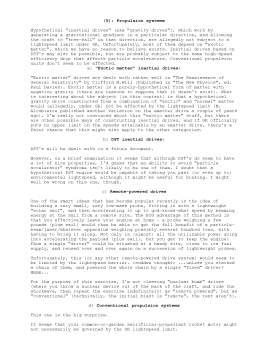Extras din curs
Lightspeed barrier: SR, intro
Just about everyone who's studied the subject knows that special relativity forbids the acceleration of a particle up to and beyond lightspeed relative to an observer. This is supposed to be because the inertial mass of the particle increases with speed, with the increase becoming significant as the speed becomes "relativistic". As the object's speed approaches c (says the argument), the mass of the object tends to infinity, so it would take an infinite amount of energy to take a particle all the way up to lightspeed. Actually, when you look at the initial postulates of SR, they pretty much presuppose that FTL travel doesn't happen.
That's the argument, anyway.
But because SR introduces so many redefinitions, it is actually possible to break the famous "lightspeed barrier" in Newtonian terms without explicitly breaking any SR laws, and to invoke gravitational or acceleration "distortion" effects as an explanation of how a hypothetical FTL object needn't overtake its own wavefront.
EASY STUFF:
(1): Playing galactic hopscotch, and travelling between multiple inertial frames provides a way of achieving (Newtonian) FTL with respect to your startpoint. When multiple intermediate frames are involved, SR helpfully responds by reinterpreting (Newtonian) FTL speeds as being subluminal. To generate those intermediate frames, all you have to do is accelerate (the SR derivation didn't claim validity for accelerating frames, remember?).
(2): "Newtonian" FTL ... - if we didn't know any better, and just slammed our foot down on the accelerator and broke lightspeed, would the folks back home ever know about it? Apparently not, because the "naughty bit" of our journey would again be obscured behind an event horizon. So does (observerspace) SR just describe a lightspeed barrier to observability, rather than what really happens? Is the lightspeed barrier purely an "observerspace" thing? Of course, under GR, acceleration is equivalent to the effect of a gravitational field ...
(3): Gravitational freefall into a black hole - is an example of "legal" FTL travel. However, (a) SR ignores gravity, and (b) the FTL part of a particle's fall allegedly can't be seen by a distant observer anyway. So there's still no direct SR contradiction.
(4): Particle accelerators (on the other hand) are a perfect example of the sort of closed-path observerspace situation that the SR lightspeed limit is likely to be valid for - our last hypothetical example could probably not be brought about using a solar sail and a home-based particle beam. But it's hardly surprising that "dumb" particles never achieve FTL with respect to the coils that are accelerating them, because at recessional lightspeed, you wouldn't necessarily expect the accelerating signal to be able to catch up with the particle to make it go any faster (think about it).
(5): Propulsion systems - some types are definitely subject to an SR-type upper limit. Others may not be.
MORE ADVANCED STUFF:
(6): Time-dilation factors and length-contractions further complicate FTL problems under SR. It seems that some SR effects aren't testable, as a matter of principle, unless you introduce those illegal accelerations again.
Preview document
Conținut arhivă zip
- Faster Than Light.doc


































